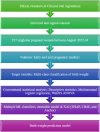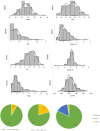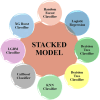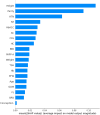Prediction of birthweight with early and mid-pregnancy antenatal markers utilising machine learning and explainable artificial intelligence
- PMID: 40683960
- PMCID: PMC12276256
- DOI: 10.1038/s41598-025-11837-7
Prediction of birthweight with early and mid-pregnancy antenatal markers utilising machine learning and explainable artificial intelligence
Abstract
Low birthweight (LBW) is a significant health challenge worldwide, as these neonates experience both short- and long-term disabilities. Factors affecting maternal and fetal health during early to mid-pregnancy can greatly influence fetal development. Prediction of birthweight using machine learning (ML) models with antenatal data may help in better clinical management. However, the lack of explainability in these models has raised concerns within the medical community. To address this issue, our study aims to develop a more practical ML model by incorporating explainable artificial intelligence (XAI). We prospectively collected real-world clinical data of 19 maternal and fetal clinical features from 237 singleton pregnancies. Statistical analyses were conducted using Jamovi (version: 2.6.26) and JASP team (2024) JASP (version: 0.18.3). Multiple ML classifiers were employed. We developed a stacked ensemble model that integrated various algorithms, including a custom-stacked ensemble approach and three XAI methodologies: Shapley Additive Explanations (SHAP), Local Interpretable Model-agnostic Explanations (LIME), and Anchor. These methods provided meaningful explanations to help construct reliable and optimal clinical predictive models. Among the ML classifiers evaluated, the AdaBoost model achieved the highest performance, with a maximum accuracy of 77%, a precision of 73%, a recall of 77%, and an F1 score of 72%. The stacked model demonstrated an accuracy of 75%, indicating its possibility in clinical application. However, the accuracy of these models might be affected by the limited dataset, which included pregnant women undergoing treatment for thyroid abnormalities, diabetes, and hypertension. Our developed model identified several key attributes that influence birthweight, such as maternal height, nuchal translucency thickness, parity, crown-rump length, glycated hemoglobin, hypertensive disorders of pregnancy, and pregnancy-associated plasma protein A. This model can assist medical professionals in making more precise birthweight predictions using routinely collected antenatal parameters, enabling timely medical decisions and treatments.
Keywords: Antenatal care; Explainable artificial intelligence; Low birthweight; Machine learning.
© 2025. The Author(s).
Conflict of interest statement
Competing interests: The authors declare no competing interests. Ethics declarations: Ethical clearance was obtained from the Kasturba Medical College and Kasturba Hospital Institutional Ethics Committee, and the ethical clearance number is IEC1:122/2022. The clinical trial registry number of the study is CTRI/2022/08/044770.
Figures











References
-
- Lees, C. C. et al. ISUOG Practice Guidelines: diagnosis and management of small-for-gestational-age fetus and fetal growth restriction. Ultrasound Obstet. Gynecol.56, 298–312 (2020). - PubMed
-
- Martin. Health—United Nations Sustainable Development. United Nations Sustainable Development https://www.un.org/sustainabledevelopment/health/#tab-3f22056b0e91266e8b2 (2023).
MeSH terms
Substances
LinkOut - more resources
Full Text Sources
Medical
Research Materials

